Last week, we looked at Achraf Hakimi, the Real Madrid right-winger who’s on loan with Borussia Dortmund. He’s emerged as a leading player for both club and the Bundesliga. With his two-year loan spell set to end, I wrapped last week’s scout report asking 1) if Hakimi fits into Real Madrid’s plans and 2) where they can utilise his abilities.
To determine whether or not Hakimi can carve out a significant role in the Spanish capital, we’ll have to take a deeper look at his competition that’s already in-house. While there’s always the possibility of Real Madrid reaching into the transfer market for help at outside-back, news of interest in David Alaba persists, the club has made significant investments in this position. Expect them to use their transfer budget elsewhere. Plus, with the talent they have at their disposal, dipping into the treasury for a position with excellent depth and reasonable top-level talent makes little sense.
Fortunately, the outside-backs contracted to Real Madrid feature either for the Spanish giants or a team that’s both competing in Europe and in the top three of La Liga or the Bundesliga. That makes the data analysis much cleaner as we’ll gauge production measured against comparable competition, squad talent and tactical approaches. The current crop of Madrid players features Marcelo, Dani Carvajal, Ferland Mendy and Nacho Fernández donning the famous white kit. Meanwhile, Achraf Hakimi plays for Dortmund, Álvaro Odriozola recently went on loan to Bayern Munich and Sergio Reguilón is helping Sevilla cling to a UEFA Champions League spot in La Liga.
In this data analysis, we first look at Real Madrid’s attacking and defensive tactics. Statistics will give an indication of where the side is finding success and where they need some help. Note that all stats are from the current season. While that limits the sample size, this is a “what have you done for me lately” industry. Transitioning from the club’s tactics to the specific role of the outside-back, we’ll then examine the established players already under contract, looking for the pairing that best fits Madrid’s tactics. Finally, as promised last week, we’ll look at Hakimi’s role if he returns to the Santiago Bernabéu Stadium. Now, bear with my preference for the use of outside-back over full-back (I promise there’s a historically valid reason for it) and let’s see which two players should start for Madrid next season.
Who fits Real Madrid’s attacking tactics?
Before we can determine Real Madrid’s top options at outside-back, we have to examine their playing philosophy and how that has taken shape through the recent coaches and players. Era Galáctica del Real Madrid has typically seen the side line-up in a 4-3-3. Given the star-power on available, an attacking formation makes perfect sense. Plus, these Madrid sides have seen their fair share of defensive tactics, so committing three players in the highest line gives them higher starting points, outlets to counter-attack and an initial wave of players to manipulate the opposing backline. That last point leads to the creation of space for additional playmakers to join the attack, especially on the wings.
This Madrid side is no different. If you’ve followed my Total Football Analysis Magazine articles, you know that the club utilises a square of Casemiro, Kroos and the centre-backs when progressing the attack into the opposition’s half. That allows the outside-backs to push higher up the pitch as wide playmakers. As those outside-backs advance, they typically push the near-sided forward into the half-space, allowing him to move closer to the goal. The additional benefit is getting numbers into the box. April’s magazine features an article on Karim Benzema and the struggles of the Real Madrid attack. Among the club’s greatest issues is the lack of production from the outside-backs.
Issues with the build-up are forcing Madrid’s attackers, especially Benzema, further back to help progress play. The added dilemma is that the current wide-forwards aren’t making the necessary runs in behind the opposition’s backline, leading to predictable attacks played entirely in front of the opposition’s defenders.
Ideally, those wide-forwards will work off of Benzema’s midfield checks, but that’s not happening. Further, the outside-backs aren’t nearly as active this season, allowing the wide-forwards to sit in the wings. During Zidane’s first spell as Real Madrid manager, it was common to see Cristiano Ronaldo drift inside as Marcelo cheated higher up the wings. That level of cooperation simply isn’t on display this season. Whether that’s due to tired legs or a lack of tactical cohesion, I’m not sure. What I do know is that the current squad is struggling to generate progressive runs and quality attacks on goal.
That brings us to our first data points. We’re going to examine all the outside-backs mentioned in the introduction, including Nacho. Though he’s really more of a central-defender, the rise of Éder Militão has shifted the Spaniard almost exclusively to the wings. When he does play, he is generally more of a stay-at-home defender, but including him in this data analysis offers a glimpse of the Real Madrid attack when Nacho is in the game.
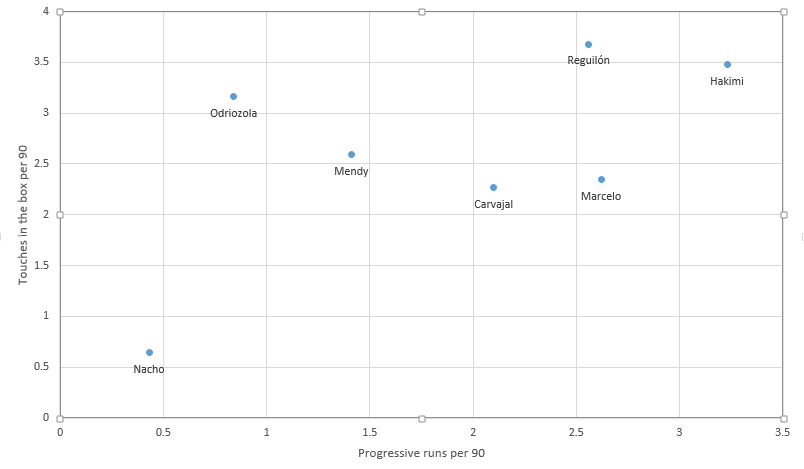
With Real Madrid featuring that deep central square of Casemiro, Kroos and the centre-backs as they enter the opponent’s half, the outside-backs can, and really should, advance higher up the pitch in support of the forwards and right-central-midfielder. Think back to Madrid’s incredible run of three-consecutive UEFA Champions League titles and you’ll no doubt recall Marcelo’s marauding runs down the left-wing and, occasionally, into the half-space. He was such a threat in attack, but with the Brazilian turning 32 this May, he’s not nearly as active. That said, he’s still the most productive attacker among the current squad, which points to the issue in the team’s attacking tactics.
Though Mendy averages more touches in the box than Carvajal, Marcelo, and Nacho, he’s the clear bronze-medal winner of the bunch in this graphic. His tendency to play a more reserved role in the attack places additional pressure on the attackers in front of him. In turn, the lack of options negatively impacts the success of the attack as his left-forward has fewer routes forward, leaving the defence with fewer threats to access. In Marcelo’s prime, he was always the more attack-oriented of the two outside-backs. With him seeing less of the field due to declining production, Mendy and Carvajal have seen the majority of the starts. The issue is that they offer a similar, more balanced approach.
At the top right of the chart, we find the two most productive outside-backs under contract, both out on loan. To be fair, Hakimi’s numbers are slightly inflated due to Borussia Dortmund’s tactics. When they play a 3-4-3, he lines up as a right-midfielder. That slightly higher starting point plays a role in his tally, but I don’t think it’s significant given that he is attack-minded and possesses a blazing speed to backtrack. While Hakimi is more naturally a right-sided player, Reguilón is a left-back. Plus, with him playing in La Liga, there’s a more accurate comparison between his numbers and the four in the current Madrid squad.
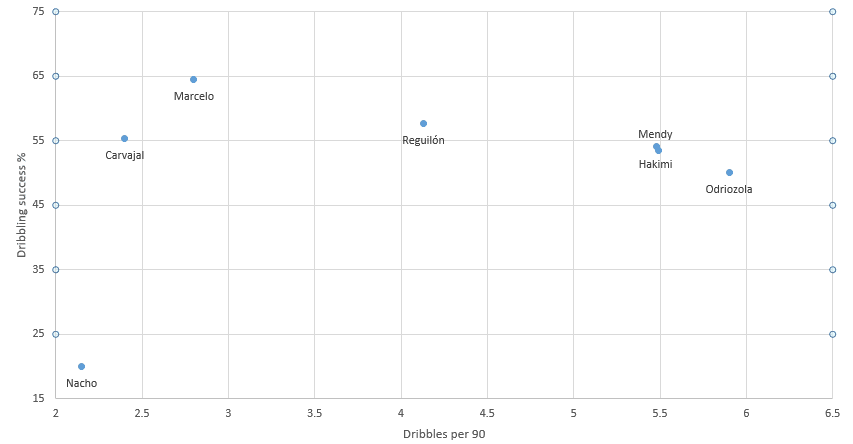
In last week’s scout report of Hakimi, I mentioned that he ranks 219th in 1v1 success at 53.44%, that despite him averaging 5.49 dribbles per game. While Marcelo’s total number of dribbles has fallen to a mere 2.8 per game, he still leads the side in dribbling success percentage at 64.52%. Among players contracted to teams in Europe’s top five leagues, that percentage leaves him tied for 71st among outside-backs. That gives an indication of just how poorly this group of players performs in 1v1 scenarios. The remaining players either rate as average or below-average dribblers among the top 386 outside-backs contracted to teams in Europe’s top five leagues.
With the lack of dribbling success among the contracted players, Madrid must undergo a deep analysis to adapt the current tactical system to the strengths of the available players. Isolating anyone other than Marcelo is more or less a coin toss as to whether or not they keep possession through the duel.
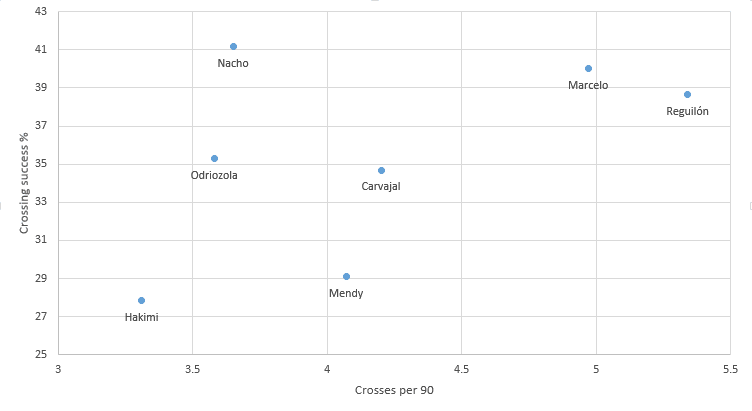
Due to the lack of runs behind the defence and poor 1v1 success rate, Madrid resort to using crosses at an unhealthy rate. In fact, Los Blancos are second in La Liga to Reguilón’s Sevilla. Real lead La Liga in xG, but they are underperforming their xG while leading the league in shots per game. Their 16.1 shots per game give an indication that Madrid’s xG lead is in large part due to the sheer number of shots taken per match.
In terms of crosses per game, Reguilón and Marcelo are in a tier of their own. The Spaniard averages 5.34 crosses per 90 minutes with a 38.66% success rate, whereas the Brazilian averages 4.97 and 40% respectively. Oddly enough, it’s Nacho who leads the side in cross success rate with 41.18% completed. In contrast, notice the remarkably poor rates of Mendy and Hakimi. If Real Madrid wants to continue prioritizing crosses, Mendy and Hakimi are not the guys you want sending those deliveries. However, it is important to note 1) studies on xG have shown that crosses are notoriously low-percentage options, especially from the deep in the wing, and 2) Madrid doesn’t have the personnel to utilise crosses. Sure, Benzema can finish from a cross, but none of the remaining attackers possesses that skillset, at least not among those who will be around next season.
Of those top three crossers, Nacho rates 57th among outside-backs contracted to teams in Europe’s top five leagues, followed by Marcelo (61st-T) and Reguilón (81st). Given the lack of elite crossers and the fundamental challenge of scoring from crosses anyway, Madrid should look at other avenues of attack. While Hakimi and Reguilón don’t shine in 1v1s, they have shown a willingness to make progressive runs and get into the box, allowing them to create from more dangerous areas. With Marcelo ageing, the attacking advantage goes to the two youngsters.
Finding the best defensive performers
Since Real Madrid control matches through their attacking play, fielding a lockdown defender in the wide areas would be a waste. That said, defensive competence is required. This takes two forms: tactically responsible defensive positioning and a combination of sound technique and anticipation.
With Casemiro, Kroos and the centre-backs secure the middle of the pitch, the outside-backs are primarily positioned higher up to participate in the attack. That means stamina and recovery pace are essential. Advantage goes to the youth in these categories, though Carvajal is as disciplined a defensive outside-back as you’ll see. He’s an opportunistic attacker, playing more conservatively to assist his centre-backs.
If Carvajal retains that role or Madrid continues to field one attack-oriented back with one who’s more defensive, the defensive qualities of that left-sided back are even less important. Regardless, let’s look at the data to see which Madrid players stand out defensively.
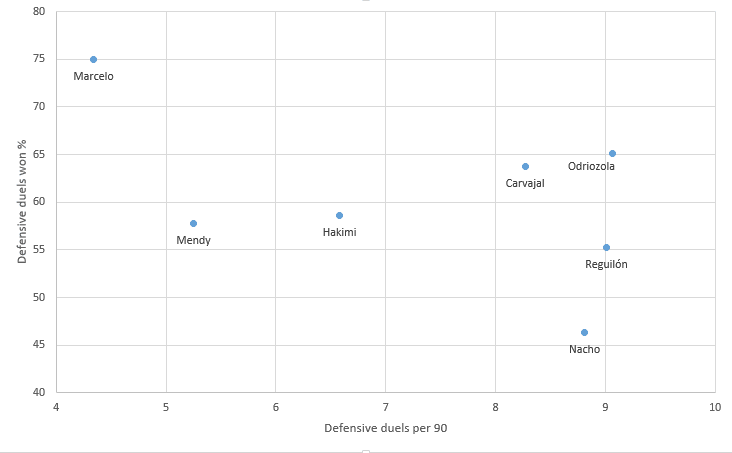
I guarantee you didn’t call Marcelo leading the outside-backs in the defensive duels won category. If that wasn’t shocking enough, know that his 75% success rate is tied for fourth in that pool of outside-backs contracted to top five European league teams. Before you scream hogwash and close the tab, keep in mind that the success rate is only one piece of the puzzle. Engaging in duels is the other portion. In that category, Marcelo rates 376th among the top 385 players who qualify with just 4.34 duels per 90 minutes. That’s down to his poor defensive positioning and recovery runs.
Again, for a team that dictates play through their attack, having an over-defensive setup is unnecessary. Looking at the numbers, Odriozola is tied for 76th in his limited action, then you have Carvajal at 105th. You’ll have to travel down the spreadsheet to the 222nd spot for the next Madrid outside-back to show (Hakimi). He and Reguilón are again comparable on the graph with the former showing better tackling ability, but the latter more active. That’s due largely to Reguilón’s counter-pressing. He averages 0.91 tackles per 90 minutes in the opposition’s first 30 yards, whereas Hakimi has a poor 0.11 tackles. Whichever combination Real Madrid prefer, Hakimi and Reguilón both have comfortable leads over Mendy. Statistics show he’s both an average tackler and an infrequent one.
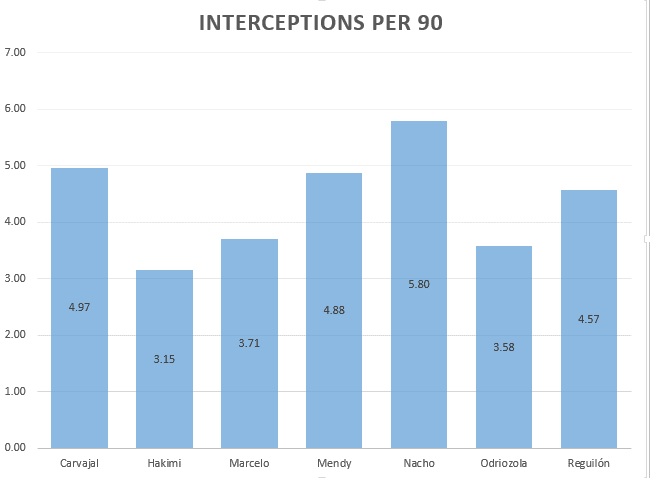
But tackling and defensive duels aren’t the only measures of successful defending. You could make the argument that tackles are only necessary when poor positioning/recoveries or an inability to intercept the pass have gifted your opponent the ball. That’s not only fair, but it’s also why players from top teams typically rate near the bottom of the list in defensive duels. Their team has the ball and, when they lose it, the side recovers quickly. That includes most outside-backs, who generally have short recovery runs because they’ve driven their mark deep into their defensive third.
This above chart on interceptions offers more clarity to the defensive activities of these seven players. Of the group, it’s no surprise that Nacho averages the most interceptions. As a true centre-back who plays the wings very conservatively, he’s primarily concerned with the defensive responsibilities of the role.
Carvajal is next on the list with a strong tally of 4.97. Between the two charts, it’s clear that he’s the strongest defensive player in this group. Mendy is right behind the Spaniard, averaging 4.88 interceptions per 90 minutes. These three make up the top tier of interceptors. Though it should be noted that Reguilón isn’t far from joining their company.
Among the remaining three players, it’s interesting to see that Hakimi rates last among the group. Going back to our pool of outside-backs contracted to teams in Europe’s top five leagues, Hakimi’s 3.15 interceptions per game rank 362nd. That shockingly low ranking is in part due to his role in Dortmund’s 3-4-3. You’ll recall that I pointed out his role within that tactical framework as a contributing factor in his high number of progressive runs. The flipside is that the quantity of his defensive actions will suffer, which is certainly a positive for Dortmund. Knowing that he is a reliable tackler and, as noted in last week’s scout report, he does have the anticipatory skills to intercept passes, the low mark doesn’t necessarily concern me, but it does complicate the comparison.
The end game
Defensively, Carvajal is still the top dog. After him, there’s not much separating Reguilón, Hakimi, Mendy and Odriozola. Each player offers some aspect of the defensive package, but not one of them is a standout. While Nacho can play a role going forward, the lack of attacking production is clear. His only real contribution is on set pieces, which we’ll address momentarily.
In terms of pure attacking talent, Marcelo, Reguilón and Hakimi are the clear top talents on the squad. With the Brazilian entering the twilight of his career, Real Madrid should look to the future and incorporate either Reguilón or Hakimi as the primary attacking threat from outside-back. Reguilón is a true left-back, so you could very easily see him claim some kind of role if Marcelo moves on from Madrid. Given his reduced production and playing time, his departure is more a case of when, not if.
While we’ve covered some of the more fundamental aspects of attacking and defensive qualities in an outside-back, we haven’t addressed the end product. That is, which of these wide playmakers is going to help Madrid score more goals.
Of this group, Hakimi, playing in that right-midfielder role at Dortmund, leads the way in goals scored with three. After him, Reguilón, Carvajal and Nacho each have one goal. Though I won’t discuss goals or xG from the 2/3 role at length, this shortlist should give you an idea of where I’m heading.
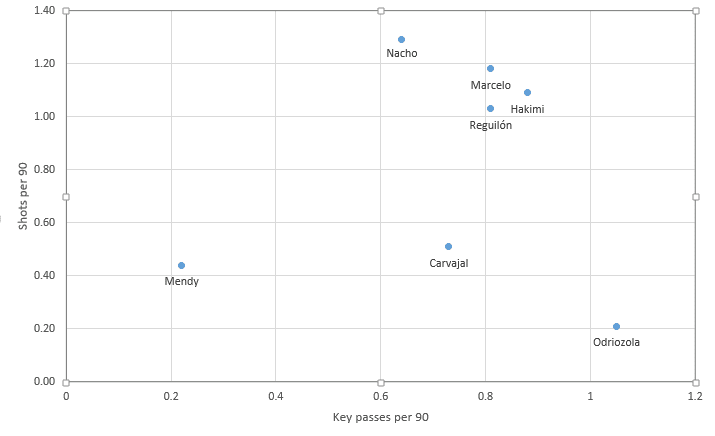
Looking at shots per 90 and key passes per 90 data, there’s a clear collection of top producers in the attacking third. That cluster of Hakimi, Reguilón and Marcelo represents Madrid’s best attacking options. Those three players have the ability to break down the opposition most effectively. Nacho’s key passes are, in large part, due to the quality of his long-range distributions. His impressive tally in the shots per 90 minutes category is down to his involvement in set pieces. That’s how he grabbed his goal this season. He’s a decent aerial threat, but this side needs more attacking power in the flow of play.
Mendy’s statistical output is perplexing. While he seems like he’s rated well in categories like touches in the box, progressive runs and interceptions, his contributions elsewhere are typically well-below average, even despite playing as the more attack-oriented of the two outside-backs on an elite team. His inconsistency and lack of end product are a real problem, especially if Madrid wants to keep the steady presence of Carvajal on the other wing.
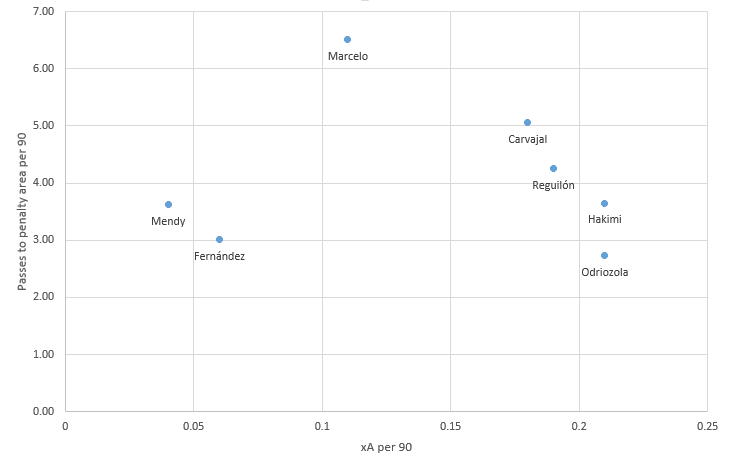
You see Mendy’s inconsistency and lack of end product on this chart too. The number of passes into the penalty area is respectable, but all those passes have equated to an average of 0.04 xA per 90, ranking 256th in that top five league pool of outside-backs. Pair that with Mendy’s season output of 0.06 xG and he’s as toothless as a pangolin.
Hakimi and Odriozola are tied for 10th among outside-backs with 0.21 xA per game, followed closely by Reguilón’s 0.19 (19th-T) and Carvajal’s 0.18 (25th-T). There’s a bit of a drop off to Marcelo’s 0.11 xA per 90 average, especially given the high number of passes he sends into the box. That gives you an indication that he’s relying on his crossing ability more frequently rather than driving into the box and setting up higher quality opportunities.
Among these seven players, Hakimi leads the way with nine assists. Granted, that’s largely from a right-midfield role in Dortmund’s 3-4-3, but it’s still an impressive mark, one that trails on Trent Alexander-Arnold’s 12 for Liverpool. Carvajal is second among the group with four assists (tying him for 12th among outside-backs), Reguilón has 3 (tied for 26th) and Marcelo’s next with two (tied for 49th). Mendy has just one assist in 1216 minutes, tying him with Odriozola’s output in 427 minutes.
Conclusion
So, who should start next season?
Real Madrid has a history of dynamic playmakers at outside-back. Watch clips of Marcelo in prime or the legendary Roberto Carlos’ ball-striking technique and you’ll understand the expectations placed on the outside-backs.
Carvajal is such a steady presence that I don’t see him losing his spot, at least not yet. At this stage in his career, he would benefit from more rotation. His performance against City in the UEFA Champions League screamed of fatigue. While Nacho offers a more defensive presence and a set-piece weapon, he’s poorly suited for the role.
Odriozola was just recently loaned out to Bayern, indicating that he either doesn’t have a future at the club or that he’s simply not ready to feature. Given the issues Madrid has had in this position, his lack of playing time and loan indicates that the 24-year-old is likely finished at Madrid.
Assuming Marcelo’s days at the Bernabéu are on the horizon, that leaves us with Mendy, Hakimi and Reguilón. Mendy cost the club €48 million just last season, but he turns 25 in June and has really struggled this season. Though it’s difficult to see Madrid moving on after a large investment and the financial toll of the COVID-19 outbreak, Mendy simply isn’t producing at a reasonable level.
That leaves us two. Madrid would do well to find spots for both Hakimi and Reguilón. The latter is a natural, attacking left-back who would offer the presence, deliveries and dynamism the current squad lacks. He’s having a great season at Sevilla and has become a key player in their attack.
Finally, we have Hakimi. Ideally, he’s Carvajal’s long-term replacement. At just 21 years of age, he’s someone Real Madrid simply can’t afford to sell. Though he’s naturally suited for the right side, he has played on the left for Dortmund. He’s a right-footed player with a strong preference of dribbling with his right foot, so it’s reasonable to think a shift to the left might handicap his dribbling.
However, remember that he’s a relatively average dribbler anyway. Hakimi’s success comes from his movement off the ball and his identification of threatening attacking spaces. Plus, since he’s a poor crosser of the ball, playing him on the right in a cross heavy system won’t get the best out of him. If he starts on the left, the presence of that left-forward, be it Eden Hazard or Vinícius Júnior, will open up the half-space for him, putting the ball on his right foot. If you go back to my analysis on Hakimi, you’ll notice one of the image sequences shows him on the left-wing. I intentionally included that sequence to offer an example of the approach he would bring to Madrid’s left-wing.
At Dortmund, it’s common to see Hakimi moving more centrally into the half-space as his side progresses into the attacking third from the left-hand side. He’s comfortable playing centrally. If he’s arriving in the central channel or the left-half space from the left-wing, he’ll have the ball on his stronger foot, enabling him to shoot or combine with teammates. If his participation on the wings necessitates crossing, he’ll serve an inswinger, which is more difficult to defend.
Real Madrid has got some decisions to make. This could, and really should, be the summer they commit to or sell each of these players. If I could only take three, Carvajal, Hakimi and Reguilón would be my choices.





Comments